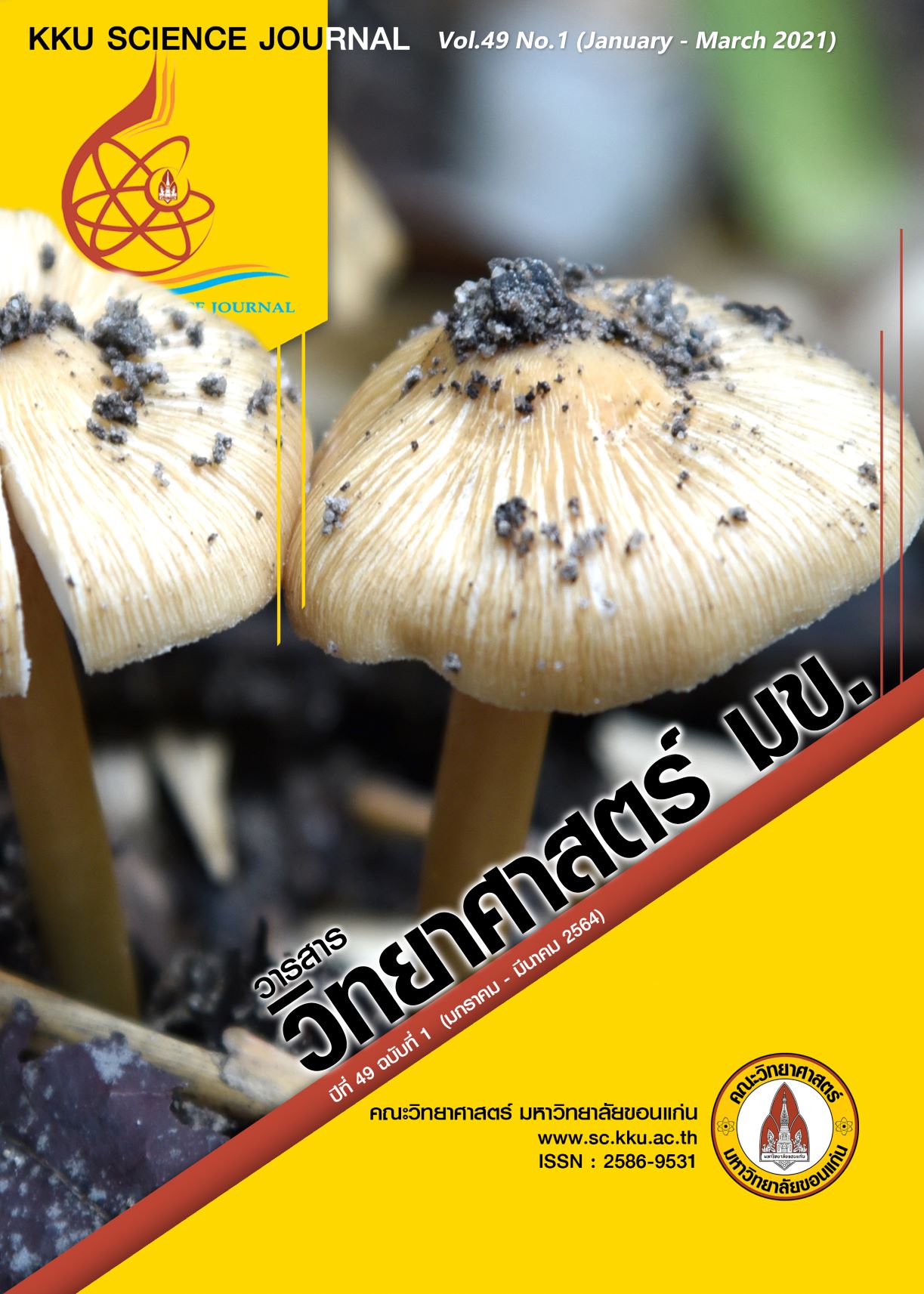Infusion Starter Culture-Based as a Model for Pilot Scale of Bradyrhizobial Inoculant Production
Main Article Content
Abstract
Bradyrhizobium is bacteria that benefits to legume plant under symbiosis condition. This process is widely recognized as biological nitrogen fixation. The objective of this study was to develop a simple technique with a low number of starter cell culture preparation for producing various types of high-quality bradyrhizobial inoculant. In this study, the starter culture of Bradyrhizobium diazoefficiens USDA110 was manually prepared to obtain the final cell concentrations starting from 10 to 106 CFU/unit. The lowest amount of cell that could be able to grow and increase the cell number in different types of inoculant was observed. It was found that the number of cells starting at the concentration of 10 CFU/unit could be able to grow and increase to more than 108 CFU/unit at 14, 21, and 14 days after inoculation (dai) in liquid-, peat-, and encapsulation-inoculants, respectively. Therefore, final cell suspension at the concentration of 10 CFU/unit was used in this study for inoculant production. The syringe- and peristaltic-pumps were incorporated with a model for pilot scale to create the micro-injection of starter culture at 10 cells/unit on different inoculant types. The results showed that all types of inoculants produced by this technique could maintain the shelf-life of inoculants for at least 3 months. This is the first demonstration of the diluent with a very low amount of starter culture. Thus, this process could be applied further for high-quality bradyrhizobial inoculant on large scale with low cost production.
Article Details

This work is licensed under a Creative Commons Attribution-NonCommercial-NoDerivatives 4.0 International License.
References
Albareda, M., Rodríguez-Navarro, D. N., Camacho, M. and Temprano, F. J. (2008). Alternatives to peat as a carrier for rhizobia inoculants: solid and liquid formulations. Soil Biology and Biochemistry 40: 2771–2779.
Bashan, Y. (1986). Alginate Beads as Synthetic Inoculant Carriers for Slow Release of Bacteria That Affect Plant Growth. Applied and Environmental Microbiology 51(5):1089-1098.
Bashan, Y., Hernandez, J. P., Leyva, L. A. and Bacilio, M. (2002). Alginate microbeads as inoculant carrier for plant growth-promoting bacteria. Biology and Fertility of Soils 35(5): 359-368.
Dart, P. J., Roughley, R. J. and Chandler, M. R. (1969). Peat culture of Rhizobium trifolii an examination by electron microscopy. Journal of applied bacteriology 32(3):352-357.
Daza, A., Santamaría, C., Rodríguez-Navarro, D. N., Camacho, M., Orive, R. and Temprano, F. (2000). Perlite as a carrier for bacterial inoculants. Soil Biology and Biochemistry 32(4): 567–572.
Denton, M. D., Phillips, L. A., Peoples, M. B., Pearce, D. J., Swan, A. D., Mele, P. M. and Brockwell, J. (2017). Legume inoculant application methods: Effects on nodulation patterns, nitrigen fixation, crop growty and yield innarrow-leaf lupin and faba bean .Plant and Soil 419: 25-39.
Einarsson, S., Gudmundsson, J., Sverrisson, H., Kristjansson, J. K and Runolfsson, S. (1993). Production of Rhizobium Inoculants for Lupinus nootkatensis on Nutrient-Supplemented Pumice. Applied and Environmental Microbiology 59(11): 3666-3668.
Feng, L., Roughley, R. J. and Copeland, L. (2002). Morphological changes of rhizobia in peat cultures. Applied and Environmental Microbiology 68(3): 1064-1070.
González-López, J., Rodelas, B., Pozo, C., Salmerón-López, V., Martínez-Toledo, M. V. and Salmerón, V. (2005). Liberation of amino acids by heterotrophic nitrogen fixing bacteria. Amino acids 28(4): 363-367.
Kannaiyan, S. (2002). Biotechnology of biofertilizers. Oxford: Alpha Science International Limited.
Malusá, E. and Vassilev, N. (2014). A contribution to set a legal framework for biofertilisers. Applied Microbiology and Biotechnology 98(15): 6599-6607.
Mohamed, S. S., Hassan, M. A. and Abdelgani, M. E. (2019). The shelf life of Rhizobial liquid inoculants amended with different polymeric additives. Australian Journal of Basic and Applied Sciences 13(11): 28-36.
Roughley, R. J. and Vincent, J. M. (1967). Growth and Survival of Rhizobium spp. in Peat Culture. Journal of Applied Bacteriology 30(2): 362-376.
Saiprasad, G. V. S. (2001). Artificial seeds and their applications. Resonance 6(5): 39-47.
Sethi, S. K. and Adhikary, S. P. (2012). Cost effective pilot scale production of biofertilizer using rhixobium and Azotobactrt. African Journal of Biotechnology 11(70): 13490-13493.
Shakhawat, H. M. and Mårtensson, A. (2008). Potential use of Rhizobium spp. to improve fitness of non-nitrogen-fixing plants. Acta Agriculturae Scandinavica, Section B-Soil and Plant Science 58(4): 352-358.
Shcherbakova, E. N., Shcherbakov, A. V., Rots, P. Y., Gonchar, L. N., Mulina, S. A., Yahina, L. M., Lactionov, Y. V. and Chebotar, V. K. (2018). Inoculation technology for legumes based on alginate encapsulation. Agronomy Research 16(5): 2156 2168.
Somasegaran, P. (1985). Inoculant production with diluted liquid cultures ofRhizobium spp. and autoclaved peat: Evaluation of diluents,Rhizobium spp. peats, sterility requirements, storage and plant effectiveness. Applied and Environmental Microbiology 50(2): 398–405.
Somasegaran, P. and Hoben, H. J. (2012). Handbook for rhizobia: methods in legume-rhizobium technology. New York: Springer Science and Business Media.
Temprano, F., Albareda, M., Camacho, M., Daza, A., Santamaria, C. and Rodríguez-Navarro, N. D. (2002) Survival of Several Rhizobium/Bradyrhizobium Strains on Different Inoculant Formulations and Inoculated Seeds. International Microbiology 5(2): 81-86.
Tittabutr, P., Payakapong, W., Teaumroong, N., Singleton, P. W. and Boonkerd, N. (2007). Growth, survival and field performance of bradyrhizobial liquid inoculants formulations with polymeric additives. Science Asia 33: 69-77.
Žvagiņa, S., Petriņa, Z., Nikolajeva, V. and Lielpētere, A. (2015). Immobilization and survival of root nodule bacterium Rhizobium leguminosarum biovar viciae. Material Science and Applied Chemistry 32: 75-79.
Singleton, P., Keyser, H. and Sande, E. (2002). Development and evaluation of liquid inoculants. In ‘Rhizobial inoculants and nitrogen fixation in Vietnam. ACIAR Proceedings No. 109e. (Ed. DF Herridge) pp. 52–66.


